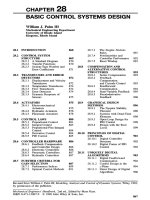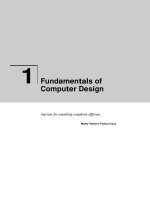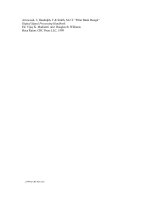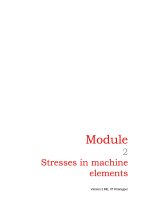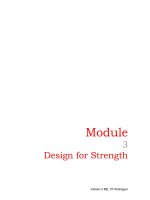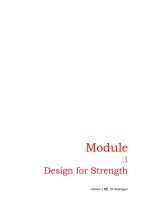Tài liệu 36 Filter Bank Design doc
Bạn đang xem bản rút gọn của tài liệu. Xem và tải ngay bản đầy đủ của tài liệu tại đây (268.29 KB, 19 trang )
Arrowood, J.; Randolph, T & Smith, M.J.T. “Filter Bank Design”
Digital Signal Processing Handbook
Ed. Vijay K. Madisetti and Douglas B. Williams
Boca Raton: CRC Press LLC, 1999
c
1999byCRCPressLLC
36
Filter Bank Design
Joseph Arrowood
Georgia Institute of Technology
Tami Randolph
Georgia Institute of Technology
Mark J.T. Smith
Georgia Institute of Technology
36.1FilterBankEquations
TheACMatrix
•
Spectral Factorization
•
Lattice Implementa-
tions
•
Time-Domain Design
36.2 Finite Field Filter Banks
36.3 Nonlinear Filter Banks
References
The interest in digital filter banks has grown dramatically over the last few years. Owing to the
trend toward lower cost, higher speed microprocessors, digital solutions are becoming attractive for
a wide variety of applications. Filter banks allow signals to be decomposed into subbands, often
facilitating more efficient and effective processing. They are particularly visible in the areas of image
compression, speech coding, and image analysis.
The desired characteristics of a subband decomposition will naturally vary from application to
application. Moreover,withinanygivenapplication, thereareamyriadofissuestoconsider. First, one
mightconsiderwhethertouseFIRorIIRfilters. IIRdesigns canoffercomputationaladvantages, while
FIR designs can offer greater flexibility in filter characteristics. In this chapter we focus exclusively
on FIR design. Second, one might identify the time-frequency or space-frequency representation
that is most appropriate. Uniform decompositions and octave-band decompositions are particularly
popular at present. At the next level, characteristics of the analysis filters should be defined. This
involves imposing specifications on the analysis filter passband deviations, transition bands, and
stopband deviations. Alternately or in addition, time domain characteristics may be imposed, such
as limits on the step response ripples, and degree of regularity.
One can consider similar constraints for the synthesis filters. For coding applications, the charac-
teristics of the synthesis filters often have a dominant effect on the subjective quality of the output.
Finally, one should consider analysis-synthesis characteristics. That is, one has flexibility to specify
the overall behavior of the system. In most cases, one views havingexact reconstructionas being ideal.
Occasionally, however, it may be possible to trade some small loss in reconstruction quality for signif-
icant gains in computation, speed, or cost. In addition to specifying the quality of reconstruction, it
is generally possible to control the overall delay of the system from end to end. In some applications,
such as two-way speech and video coding, latency represents a source of quality degradation. Thus,
having explicit control over the analysis-synthesis delay can lead to improvement in quality.
The intelligent design of applications-specific filter banks involves first identifying the relevant
parameters and optimizing the system with respect to them. As is typical, the filter bank analysis and
reconstruction equations lead to complex tradeoffs among complexity, system delay, filter quality,
filter length, and quality of performance. This chapter is devoted to presenting an introduction to
filter bank design. Filter bank design has reached a state of maturity in many regards. To cover all of
c
1999 by CRC Press LLC
FIGURE 36.1: Block diagram of an M-band analysis-synthesis filter bank.
FIGURE 36.2: Two-band analysis-synthesis filter bank.
the important contributions in any level of detail would be impossible in a single chapter. However,
it is possible to gain some insight and appreciation for general design strategies germane to this topic.
In addition to discussing design methodologies for linear analysis-synthesis systems, we also consider
the design of a couple of new nonlinear classes of filter banks that are currently receiving attention
in the literature. This discussion along with the referenced articles should provide a convenient
introduction to the design of many useful filter banks.
36.1 Filter Bank Equations
A broad class of linear filter banks can be represented by the block diagram shown in Fig. 36.1. This
is a linear time-varying system that decomposes the input into M-subbands, each one of which is
decimated by a factor of R. When R = M, the system is said to be critically sampled or maxi-
mally decimated. Maximally decimated systems are generally the ones of choice because they can be
information preserving, and are not data expansive.
The simplest filter bank of this class is the two-band system, an example of which is shown in
Fig. 36.2. Here, there are only two analysis filters: H
0
(z), a lowpass filter; and H
1
(z), a highpass filter.
Similarly, there are two synthesis filters: a lowpass G
0
(z), and a highpass G
1
(z). Let us consider this
two-band filter bank first. In the process, we will develop a design methodology that can be extended
to the more complex problem of M-band systems.
Examining the two-band filter bank in Fig. 36.2, we see that the input x[n] is lowpass and highpass
filtered, resulting in v
0
[n] and v
1
[n]. These signals are then downsampled by a factor of two, leading
to the analysis section outputs, y
0
[n] and y
1
[n]. The downsampling operation is time varying,
which implies a non-trivial relationship between v
k
[n] and y
k
[n] (where k = 0, 1). In general,
downsampling a signal v
k
[n] by an integer factor R is described in the time domain by the equation
y
k
[n]=v
k
[Rn].
c
1999 by CRC Press LLC
In the frequency domain, this relationship is given by
Y
k
e
jω
=
1
R
R−1
r=0
V
k
e
j
ω
R
+
2πr
R
.
The equivalent equation in the z domain is
Y
k
(z) =
1
R
R−1
r=0
V
k
W
r
R
z
1
R
where W
r
R
= e
−j
2πr
R
.
In the synthesis section, the subband signals y
0
[n] and y
1
[n] are upsampled to give s
0
[n] and s
1
[n].
They are then filtered by the lowpass and highpass filters, G
0
(z) and G
1
(z), respectively, before being
summed together. The upsampling operation (for an arbitrary positive integer R) can be defined by
s
k
[n]=
y
k
[n/R] for n = 0, ±R, ±2R, ±3R,...
0 otherwise
in the time domain, and
S
k
e
jω
= Y
k
e
jRω
and S
k
(z) = Y
k
z
R
in the frequency and z domains, respectively.
Using the expressions for the downsampling and upsampling operations, we can describe the
two-band filter bank in terms of z-domain equations. The outputs after analysis filtering are
V
k
(z) = H
k
(z)X(z), k = 0, 1.
After decimation and recognizing that W
1
2
=−1, we obtain
Y
k
(z) =
1
2
H
k
z
1
2
X
z
1
2
+ H
k
−z
1
2
X
−z
1
2
,k= 0, 1.
(36.1)
Thus, Eq. (36.1) defines completely the input-output relationship for the analysis section in the z
domain.
In the synthesis section, the subbands are upsampled giving
S
k
(z) = Y
k
(z
2
), k = 0, 1.
This implies that
S
k
(z) =
1
2
(
H
k
(z)X(z) + H
k
(−z)X(−z)
)
,k= 0, 1.
Passing S
k
(z) through the synthesis filters and then summing yields the reconstructed output
ˆ
X(z) =
1
2
G
0
(z)
[
H
0
(z)X(z) + H
0
(−z)X(−z)
]
+
1
2
G
1
(z)
[
H
1
(z)X(z) + H
1
(−z)X(−z)
]
.
(36.2)
For virtually any application for which one can conceive, the synthesis filters should allow the input
to be reconstructed exactly or with a minimal amount of distortion. In other words, ideally we want
ˆ
X(z) = z
−n
0
X(z) ,
where n
0
is the integer system delay. An intuitive approach to handing this problem is to use the
AC-matrix formulation, which we introduce next.
c
1999 by CRC Press LLC
36.1.1 The AC Matrix
The aliasing component matrix (or AC matrix) represents a simple and intuitive idea originally
introducedin[6] for handling analysis and reconstruction. The analysis-synthesis equation (36.2)
for the two-band case can be expressed as
ˆ
X(z) =
1
2
[
H
0
(z)G
0
(z) + H
1
(z)G
1
(z)
]
X(z)
+
1
2
[
H
0
(−z)G
0
(z) + H
1
(−z)G
1
(z)
]
X(−z) .
The idea of the AC matrix is to represent the equations in matrix form. For the two-band system,
this results in
ˆ
X(z) =
1
2
[
X(z),X(−z)
]
H
0
(z) H
1
(z)
H
0
(−z) H
1
(−z)
AC matrix
G
0
(z)
G
1
(z)
,
where the AC matrix is as shown above. The AC matrix is so designated because it contains the
analysis filters and all the associated aliasing components. Exact reconstruction is then obtained
when
H
0
(z) H
1
(z)
H
0
(−z) H
1
(−z)
G
0
(z)
G
1
(z)
=
T(z)
0
where T(z)is required to be the scaled integer delay 2z
−n
0
.ThetermT(z)is the transfer function
of the overall system. The zero term below T(z)determines the amount of aliasing present in the
reconstructed signal. Because this term is zero, all aliasing is explicitly removed.
With the equations expressed in matrix form, we can solve for the synthesis filters, which yields
G
0
(z)
G
1
(z)
=
1
H
0
(z)H
1
(−z) − H
0
(−z)H
1
(z)
H
1
(−z) −H
1
(z)
−H
0
(−z) H
0
(z)
T(z)
0
.
(36.3)
Often for a variety of reasons, we would like both the analysis and synthesis filters to be FIR. This
means the determinant of the AC matrix should be a constant delay. The earliest solution to the FIR
filter bank problem was presented by Croisier et al. in 1976 [18]. Their solution was to let
H
1
(z) = H
0
(−z)
and
G
0
(z) = H
0
(z)
G
1
(z) =−H
0
(−z) .
This is the quadrature mirror filter (QMF) solution. From the equations in (36.3), it can be seen that
this solution cancels all the aliasing and results in a system transfer function
T(z)= H
0
(z)H
1
(−z) − H
0
(−z)H
1
(z) .
As it turns out, with careful design T(z)can be made to be close to a constant delay. However, some
amount of distortion will always be present. In 1980 Johnston designed a set of optimized QMFs
which are now widely used. The coefficient values may be found in several sources [16, 17, 19].
Interestingly, the equations in (36.3) imply that exact reconstruction is possible by forcing the
AC-matrix determinant to be a constant delay. The design of such exact reconstruction filters is
discussed in the next section.
c
1999 by CRC Press LLC
FIGURE 36.3: Example of a zero-phase half-band lowpass filter.
36.1.2 Spectral Factorization
The question at hand is how dowe determine H
0
(z) and H
1
(z) such that T(z)is an integer delay z
−n
0
.
A solution to this problem was introduced in 1984 [7], based on the observation that H
0
(z)H
1
(−z)
is a lowpass filter [which we denote F
0
(z)] and H
0
(−z)H
1
(z) is its corresponding frequency shifted
highpass filter. A unity transfer function can be constructed by forcing F
0
(z) and F
0
(−z) to be
complementary half-band lowpass and highpass filters. Many fine techniques are available for the
design of half-band lowpass filters, such as the Parks-McClellan algorithm, Kaiser window design,
Hamming window design, the eigenfilter method, and others. Zero-phase half-band filters have the
property that zeros occur in the impulse response at n =±2, ±4, ±6,..., etc. An illustration is
shown in Fig. 36.3. Once designed, F
0
(z) can be factored into two lowpass filters, H
0
(z) and H
1
(−z).
The design procedure can be summarized as follows.
1. First design a
(
2N − 1
)
-tap half-band lowpass filter, using the Parks-McClellan algo-
rithm, for example. This can be done by constraining the passband and stopband cutoff
frequencies to be ω
p
= π −ω
s
, and using equal passband and stopband error weightings.
The resulting filter will have equal passband and stopband ripples, i.e., δ
p
= δ
s
= δ.
2. Add the value δ to the f [0] (center) tap value. This forces F(e
jω
) ≥ 0 for all ω.
3. Spectrally factor F(z) into two lowpass filters, H
0
(z) and H
1
(−z). Generally the best
waytofactorF(z)is such that H
1
(−z) = H
0
(z
−1
). Note that the factorization will not
be unique and the roots should be split so that if a particular root is assigned to H
0
(z),
its reciprocal should be given to H
0
(z
−1
).
The result of the above procedure is that H
0
(z) will be a power complementary, even length, FIR
filter that will form the basis for a perfect reconstruction filter bank. Note that since H
1
(z) is just a
time-reversed, spectrally shifted version of H
0
(z),
H
0
(e
jω
)
=
H
1
(−e
jω
)
.
Smith and Barnwell designed and published a set of optimal exact reconstruction filters [1]. The
filter coefficients for H
0
(z) are given in Table 36.1. The analysis and synthesis filters are obtained
from H
0
(z) by
G
0
(z) = H
0
z
−1
G
1
(z) = H
0
(−z)
H
1
(z) = H
0
−z
−1
.
A complete discussion of this approach can be found in many references [1, 6, 7, 25, 27, 28].
c
1999 by CRC Press LLC
TABLE 36.1 CQF (Smith-Barnwell) Filter Bank
Coefficients with 40dB Attenuation
32-Tap filter 16-Tap filter
8.494372478233170D
−
03 2.193598203004352D
−
02
−
9.617816873474045D
−
05 1.578616497663704D
−
03
−
8.795047132402801D
−
03
−
6.025449102875281D
−
02
7.087795490845020D
−
04
−
1.189065962053910D
−
02
1.220420156035413D
−
02 0.137537915636625D
+
00
−
1.762639314795336D
−
03 5.745450056390939D
−
02
−
1.558455903573829D
−
02
−
0.321670296165893D
+
00
4.082855675060479D
−
03
−
0.528720271545339D
+
00
1.765222024089335D
−
02
−
0.295779674500919D
+
00
−
8.385219782884901D
−
03 2.043110845170894D
−
04
−
1.674761388473688D
−
02 2.906699709446796D
−
02
1.823906210869841D
−
02
−
3.533486088708146D
−
02
5.781735813341397D
−
03
−
6.821045322743358D
−
03
−
4.692674090907675D
−
02 2.606678468264118D
−
02
5.725005445073179D
−
02 1.033363491944126D
−
03
0.354522945953839D
+
00
−
1.435930957477529D
−
02
0.504811839124518D
+
00
0.264955363281817D
+
00
−
8.329095161140063D
−
02
−
0.139108747584926D
+
00
3.314036080659188D
−
02
9.035938422033127D
−
02
−
1.468791729134721D
−
02 8-Tap filter
−
6.103335886707139D
−
02
6.606122638753900D
−
03 3.489755821785150D
−
02
4.051555088035685D
−
02
−
1.098301946252854D
−
02
−
2.631418173168537D
−
03
−
6.286453934951963D
−
02
−
2.592580476149722D
−
02 0.223907720892568D
+
00
9.319532350192227D
−
04 0.556856993531445D
+
00
1.535638959916169D
−
02 0.357976304997285D
+
00
−
1.196832693326184D
−
04
−
2.390027056113145D
−
02
−
1.057032258472372D
−
02
−
7.594096379188282D
−
02
For the M-channel case shown in Fig. 36.1, where the bands are assumed to be maximally deci-
mated, the same AC-matrix approach can be employed, leading to the equations
ˆ
X(z) =
1
M
X(z),...,X(zW
M−1
M
)
x
T
H
0
(z) ··· H
M−1
(z)
H
0
(zW
1
M
) ··· H
M−1
(zW
1
M
)
.
.
.
.
.
.
H
0
(zW
M−1
M
) ··· H
M−1
(zW
M−1
M
)
H
G
0
(z)
G
1
(z)
.
.
.
G
M−1
(z)
g
,
where W
M
= e
−j
2π
M
. This can be rewritten compactly as
ˆ
X(z)
1
M
x
T
(z)H(z)g(z) ,
where x is the input vector, g is the synthesis filter vector, and H is the AC matrix. However, the AC-
matrix determinant for systems with M>2 is typically too intricate for the spectral factorization
approach outlined above. An effective approach for handling the design of M-band systems was
introduced by Vaidyanathanin [30]. It is based on a lattice implementation structure and is discussed
next.
c
1999 by CRC Press LLC



